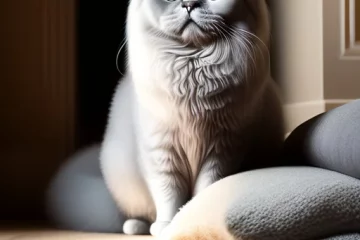Persian cats, known for their luxurious coats and striking appearance, have captivated cat lovers around the world.
With their distinctive features and gentle demeanor, these elegant felines have become one of the most popular cat breeds globally.
In this article, we will delve into the fascinating world of Persian cats, exploring their history, physical characteristics, personality, care requirements, health considerations, and more.

History of the Persian Cat Breed
The Persian cat breed has a rich and intriguing history that dates back centuries.
Originating in Persia (modern-day Iran), these cats were first introduced to Europe in the 17th century.
Merchants and explorers discovered these beautiful felines during their travels and brought them back to their home countries.
Over time, the breed gained recognition and popularity, eventually making its way to the United States.
Physical Characteristics
One of the most captivating aspects of Persian cats is their distinct physical appearance.
These cats have a round face with a flat nose, large round eyes, and small ears set wide apart.
Their bodies are medium to large in size, with sturdy bone structure and a well-balanced stance. However, it is their long, dense coat that truly sets them apart.
Persian cats have a luxurious, flowing coat that requires regular grooming to keep it in optimal condition.
Personality and Temperament
Beyond their enchanting looks, Persian cats are renowned for their gentle and calm nature.
They tend to be laid-back and prefer a serene and peaceful environment.
Persian cats are known for their affectionate and sweet disposition, often forming strong bonds with their human companions.
They enjoy being petted and cuddled, and their calm demeanor makes them excellent lap cats.
While they may not be as energetic as some other breeds, they still appreciate interactive play sessions and engaging toys.
You May Like: The Personality of Persian Cats: All That You Need To Know
Care and Grooming
Due to their long and dense coats, Persian cats require regular grooming to keep their fur healthy and mat-free.
Daily brushing is essential to prevent tangles and mats from forming.
Additionally, periodic bathing is recommended to keep their coats clean and free from dirt and oils.
Persian cats also have unique eye care needs due to their facial structure.
Regular eye cleaning can help prevent tear stains and eye infections.
It’s crucial to establish a grooming routine early on to ensure your Persian cat’s coat remains in optimal condition.
Health and Common Issues
While Persian cats are generally healthy and hardy, they may be prone to certain health issues.
Some common problems include polycystic kidney disease (PKD), hypertrophic cardiomyopathy (HCM), and respiratory difficulties due to their flat faces.
Regular veterinary check-ups, a balanced diet, and a clean living environment can help prevent and address these issues.
As responsible pet owners, it’s essential to be aware of the potential health concerns associated with the breed and take appropriate measures to ensure the well-being of your Persian cat.

Feeding and Nutrition
Proper nutrition plays a vital role in maintaining the overall health and well-being of Persian cats.
A balanced diet that meets their specific nutritional needs is essential.
High-quality cat food, whether commercially prepared or homemade under veterinary guidance, should provide the necessary nutrients.
Portion control is also important to prevent obesity, as Persian cats can be more prone to weight gain.
Consult with your veterinarian to determine the appropriate feeding regimen for your Persian cat.
You May Like: Feeding Persian Cats: Complete Guide
Training and Exercise
While Persian cats may not require as much exercise as some other breeds, they still benefit from mental stimulation and physical activity.
Interactive toys, scratching posts, and puzzle feeders can provide mental enrichment.
Encouraging playtime and providing climbing opportunities can help keep them physically active.
Training Persian cats can be a rewarding experience, as they are intelligent and eager to please.
Positive reinforcement methods work best when teaching them basic commands or tricks.
You May Also Like: Training Your Persian Cat: Best Tips And Tricks
Living Environment
Creating a suitable living environment is essential for the well-being of Persian cats.
They thrive in calm and quiet surroundings, making them ideal companions for individuals or families living in apartments or houses.
Providing cozy spots for them to relax, such as soft beds or heated blankets, can make them feel secure and content.
Persian cats also enjoy looking out of windows, so having perches or window shelves can fulfill their natural curiosity.
Persian Cats as Pets
Persian cats make wonderful pets for individuals and families seeking a gentle and affectionate companion.
Their calm and docile nature makes them well-suited for households with a relaxed atmosphere.
However, it’s important to note that Persian cats may require more grooming and maintenance compared to some other breeds.
Additionally, their long coats can shed, so regular cleaning and vacuuming may be necessary to keep the living environment tidy.
Considering these factors, owning a Persian cat can be a fulfilling and rewarding experience for the right owner.
You May Like: The Difference Between Male and Female Persian Cats
Breeding and Adoption
For those interested in breeding Persian cats, it’s crucial to follow responsible breeding practices.
This includes genetic testing to minimize the risk of passing on hereditary health conditions.
Many reputable breeders adhere to strict standards and prioritize the health and well-being of their cats.
Alternatively, adoption is an excellent option for those who wish to provide a loving home to a Persian cat in need.
Rescue organizations and shelters often have Persian cats available for adoption, offering a chance to give these beautiful felines a second chance at a happy life.
You May Like: Breeding Persian Cats: A Comprehensive Guide
Conclusion
Persian cats are a captivating breed renowned for their distinctive looks and gentle temperament.
From their origins in Persia to their popularity worldwide, they have become beloved pets for many cat enthusiasts.
While they require regular grooming and specific care needs, the rewards of owning a Persian cat are immeasurable.
Their affectionate nature, calm demeanor, and striking appearance make them cherished companions for individuals and families alike.
FAQs
Are Persian cats hypoallergenic?
No, Persian cats are not hypoallergenic. Their long coats can trap allergens such as dander, making them less suitable for individuals with allergies.
Do Persian cats get along with other pets?
Persian cats can coexist with other pets, but introductions should be done gradually and supervised. Proper socialization and a peaceful environment are key to successful pet interactions.
How often should I groom my Persian cat?
To prevent matting and tangles, it is important to groom Persian cats on a daily basis. Regular brushing, bathing, and eye cleaning should be part of their grooming routine.
Are Persian cats prone to obesity?
Yes, Persian cats can be prone to obesity. It’s important to monitor their diet, provide appropriate portion sizes, and encourage regular exercise to maintain a healthy weight.
Can Persian cats be left alone for long periods?
Persian cats are generally independent and can tolerate being alone for moderate periods. However, they thrive on human companionship and may become lonely or bored if left alone for extended periods. Regular interaction and stimulation are crucial for their well-being.
Do Persian cats require any special grooming tools?
While Persian cats can be groomed with regular cat grooming tools, some owners find specific tools like wide-toothed combs, grooming gloves, or specialized brushes designed for long-haired breeds to be more effective in maintaining their coat’s health and appearance.
Are Persian cats suitable for families with children?
Persian cats can be a great addition to families with children. Nevertheless, it is crucial to educate children on the gentle and respectful handling and interaction with cats. Supervision is necessary to ensure the well-being of both the children and the cat.
How often should I trim my Persian cat’s nails?
Trimming your Persian cat’s nails every 2-3 weeks is generally recommended. Regular nail trims help prevent overgrowth, reduce the risk of accidental scratching, and promote the overall comfort and health of your cat.
Are Persian cats prone to eye-related issues?
Yes, Persian cats are more susceptible to eye-related problems due to their facial structure. Conditions such as eye infections, excessive tearing, or entropion (inward rolling of the eyelids) may require veterinary attention. Regular eye cleaning and monitoring can help detect any issues early.
Do Persian cats require a specific diet?
Persian cats benefit from a balanced, high-quality cat food that meets their nutritional needs. Some owners prefer to feed them wet food or a combination of wet and dry food to ensure adequate hydration. It’s essential to consult with your veterinarian to determine the most suitable diet for your Persian cat’s specific requirements.


